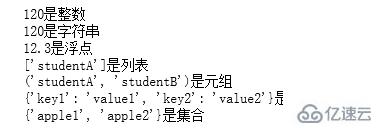您好,登錄后才能下訂單哦!
您好,登錄后才能下訂單哦!
這篇文章將為大家詳細講解有關python怎么判斷變量的類型,小編覺得挺實用的,因此分享給大家做個參考,希望大家閱讀完這篇文章后可以有所收獲。
python的數據類型有:數字(int)、浮點(float)、字符串(str),列表(list)、元組(tuple)、字典(dict)、集合(set)
一般通過以下方法進行判斷:
1、isinstance(參數1,參數2)
描述:該函數用來判斷一個變量(參數1)是否是已知的變量類型(參數2) 類似于type()
參數1:變量
參數2:可以是直接或間接類名、基本類型或者由它們組成的元組。
返回值: 如果對象的類型與參數二的類型(classinfo)相同則返回 True,否則返回 False
例子:
#判斷變量類型的函數
def typeof(variate):
type=None
if isinstance(variate,int):
type = "int"
elif isinstance(variate,str):
type = "str"
elif isinstance(variate,float):
type = "float"
elif isinstance(variate,list):
type = "list"
elif isinstance(variate,tuple):
type = "tuple"
elif isinstance(variate,dict):
type = "dict"
elif isinstance(variate,set):
type = "set"
return type
# 返回變量類型
def getType(variate):
arr = {"int":"整數","float":"浮點","str":"字符串","list":"列表","tuple":"元組","dict":"字典","set":"集合"}
vartype = typeof(variate)
if not (vartype in arr):
return "未知類型"
return arr[vartype]
#判斷變量是否為整數
money=120
print("{0}是{1}".format(money,getType(money)))
#判斷變量是否為字符串
money="120"
print("{0}是{1}".format(money,getType(money)))
money=12.3
print("{0}是{1}".format(money,getType(money)))
#判斷變量是否為列表
students=['studentA']
print("{0}是{1}".format(students,getType(students)))
#判斷變量是否為元組
students=('studentA','studentB')
print("{0}是{1}".format(students,getType(students)))
#判斷變量是否為字典
dictory={"key1":"value1","key2":"value2"}
print("{0}是{1}".format(dictory,getType(dictory)))
#判斷變量是否為集合
apple={"apple1","apple2"}
print("{0}是{1}".format(apple,getType(apple)))返回:

2、通過與已知類型的常量進行比較
例子:
#判斷變量類型的函數
def typeof(variate):
type1 = ""
if type(variate) == type(1):
type1 = "int"
elif type(variate) == type("str"):
type1 = "str"
elif type(variate) == type(12.3):
type1 = "float"
elif type(variate) == type([1]):
type1 = "list"
elif type(variate) == type(()):
type1 = "tuple"
elif type(variate) == type({"key1":"123"}):
type1 = "dict"
elif type(variate) == type({"key1"}):
type1 = "set"
return type1
# 返回變量類型
def getType(variate):
arr = {"int":"整數","float":"浮點","str":"字符串","list":"列表","tuple":"元組","dict":"字典","set":"集合"}
vartype = typeof(variate)
if not (vartype in arr):
return "未知類型"
return arr[vartype]
#判斷變量是否為整數
money=120
print("{0}是{1}".format(money,getType(money)))
#判斷變量是否為字符串
money="120"
print("{0}是{1}".format(money,getType(money)))
money=12.3
print("{0}是{1}".format(money,getType(money)))
#判斷變量是否為列表
students=['studentA']
print("{0}是{1}".format(students,getType(students)))
#判斷變量是否為元組
students=('studentA','studentB')
print("{0}是{1}".format(students,getType(students)))
#判斷變量是否為字典
dictory={"key1":"value1","key2":"value2"}
print("{0}是{1}".format(dictory,getType(dictory)))
#判斷變量是否為集合
apple={"apple1","apple2"}
print("{0}是{1}".format(apple,getType(apple)))返回:

補充:
isinstance() 與 type() 區別:
type() 不會認為子類是一種父類類型,不考慮繼承關系。
isinstance() 會認為子類是一種父類類型,考慮繼承關系。
如果要判斷兩個類型是否相同推薦使用 isinstance()。
關于python怎么判斷變量的類型就分享到這里了,希望以上內容可以對大家有一定的幫助,可以學到更多知識。如果覺得文章不錯,可以把它分享出去讓更多的人看到。
免責聲明:本站發布的內容(圖片、視頻和文字)以原創、轉載和分享為主,文章觀點不代表本網站立場,如果涉及侵權請聯系站長郵箱:is@yisu.com進行舉報,并提供相關證據,一經查實,將立刻刪除涉嫌侵權內容。